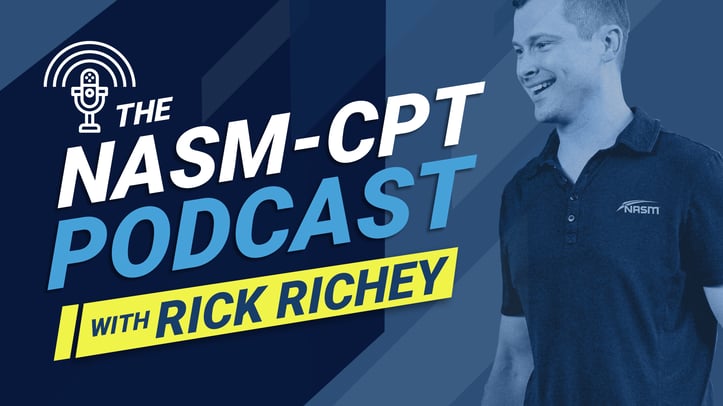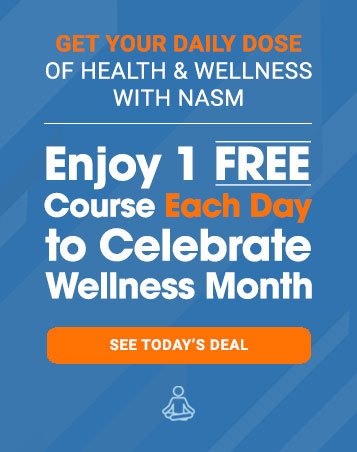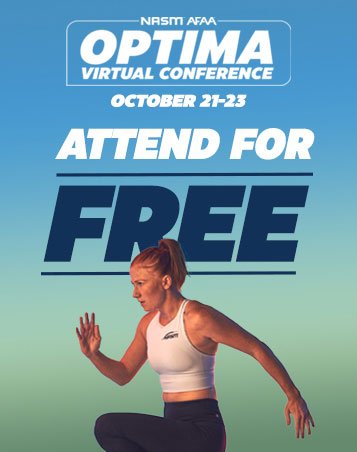里克·里奇是NASM-CPT,消费电子产品展,PES.,掌握教练。
订阅:苹果的播客/Spotify/谷歌的播客
记录:
里克·克伦:
大家好,欢迎来到NSM CPT播客。我叫里克·里奇。今天,我们继续我们的学习指导我们的CPT第七期的指导学习。再说一遍,这些都是你们可以遵循的特别是如果你们在准备NSM CPT 7考试的话。如果你已经是一名NSM认证的私人教练,这真的是一些很好的内容,你可以听一听,作为复习,我认为它会派上用场的。今天,我们将讨论特殊人群。这是程序设计的第二部分。20%的考试内容来自程序设计。上一集,我们讨论了OP t模型。在这一集里,我们将讨论特殊人群。 And for those of you who are following along in the chapters, section six, this is these are chapters 2122 and 23. So get into it, special populations. First thing we're going to talk about is youth training. So when working with youth, here's what we're going to do, I'm going to go through frequency intensity duration, the fitness assessments that you can do, the flexibility programs that you might put in place, and then the types of resistance training that may be beneficial to the youth training client. Now, with that said, progression should be based on postural control and physical capabilities. And that's true for any group. But the neuromuscular inefficiencies are oftentimes seen in youth, as they start to add the weight and resistance particularly for the first time, then that it's hard to control those degrees of freedom. So make sure we're basing this on what they can do. And not focused on having them do things that they can't do, or at least Well, we're going to emphasis on less load, and less weight, and more on how fun. These physical activities are. Why? Because this isn't just about personal training. This isn't about coming in and lifting weights necessarily. It is about movement in what you should be doing. So here's our frequency. How often should you be working out exercising or engaging in physical activity, and the truth is five to seven days a week, five to seven days a week for 60 minutes for 60 minutes every day, five to seven days a week, moderate to vigorous cardiovascular exercise training, that should be the focus for our youth. Now, if you're saying hey, Rick, I'm I'm a coach for a volleyball team or I'm a coach for a little league peewee football baseball team. Is there a different way that we should be training? Well, you should be doing skill training. That skill training comes in very handy as you are teaching them skills to go along with their sports. But in general, we're looking at youth five to seven days a week with a moderate to vigorous cardio respiratory exercise intensity, which for them is called playing. And they should be doing that for 60 minutes a day. Physical assessments, you can do overhead squat assessment, push up assessments, and then different cardiovascular assessments like the YMCA step test would be notable for them. And then flexibility self myofascial techniques, static stretching, active stretching, dynamic, stretching, the whole flexibility continuum can fit within the youth training, and then resistance training one to two sets, eight to 12 repetitions of 40 to 70% intensity. doing that for two to three days a week.
好吧,这是我们的青年培训。bob官方app让我们现在进入肥胖客户。所以我们有可能进入健身房的客户,工作是肥胖的,但他们也不能与我们应该与教学和教练和我们一起教学和教练和我们很多人一起使用的一些节目来进入健身房这些天正在做更多的事情,然后我们正在一次培训。bob官方app所以这不是必然是在健身房里面有什么锻炼。但是与肥胖的客户合作的协议是什么?首先,我们想确保我们的客户很舒服。再次,适用于任何客户。我们谈论专门为我们的客户提供肥胖,确保他们舒服。所以泡沫滚动,让它们爬到地板上,使用泡沫滚筒,这可能并不是非常舒适的东西,或者是基于地板的练习可能不会让他们感到舒适。 So being aware of your clients comfort level, and how do you know, ask them, ask your clients how comfortable they are, while doing some of the things and waiting you know what we're talking about. They know what we're talking about when we clarify this. I'm not talking about is it difficult or simple. I'm talking about your comfort level with doing the physical activity that we're doing exercises, if needed should be performed in a standing or seated position. And clients may have other underlying health issues. So a medical release may be necessary for our clients that are obese. Now let's get into the protocols. So these are general protocols for physical activity for obese clients. frequency, how often are they working out the answer at least five days a week. intensity, how intense is the workout for this this special population, the intensity should between be between 60 and 80% of the max heart rate. So the intensity 60 to 80% of Max heart rate and duration 40 to 60 minutes per day, or a 20 to 30 minute session twice each day. See, because you don't have to do it all at one go. You can break up exercises. And what we're trying to do is accumulate minutes, how many minutes 40 to 60 minutes, or 20 to 30 minutes two times a day, at least five days a week at the intensity of 60 to 80% of the max heart rate. Fitness assessments may include an overhead squat assessment, pushing and pulling assessments, and then your flexibility, what flexibility that you can utilize with your clients. And then the resistance training can move into the PT model and follow some of those constructs.
好的,糖尿病的人呢?因此,有两种类型的糖尿病主要是您将与两种糖尿病患者的糖尿病,这是我们人口糖尿病患者的95%。有一件事要确保您的糖尿病患者有适当的鞋类。您希望确保有一个小吃,碳水化合物的快速来源。为什么?好吧,因为他们的血糖趋于升高。为什么我保持糖?嗯,大多数人也是在药物上保持血糖的下降。嗯,运动非常好,保持血糖下降。但是,如果你有这样的药物,你开始锻炼,那么人们可以得到相当摇摇欲坠,低血糖会导致晕厥和更糟糕,特别是对于那些胰岛素依赖的人来说。 So be aware of that and keep a quick source of carbohydrate close by avoid excessive plyometrics and other forms of high intensity training doesn't mean that they can't do that. But it's all dependent on the client. And everything's based off of assessments but something that you might want to avoid excessive plyometrics and high intensity training. And then self myofascial techniques may be contra indicated, and may be something rolling on their legs where they may have a peripheral vascular disease and peripheral neuropathy. Self myofascial techniques may be contra indicated for people with diabetes. No, right. hypertension and coronary artery disease. Oh, by the way, we're looking at frequency of the diabetes and exercise we're going to have the same workouts that we might see here in the hypertension and coronary heart disease. So let's talk about hypertension and coronary heart disease. First of all, avoid heavy lifting. Clients should be breathing normally. So avoid heavy lifting, avoid clenching fists while training and modify tempo to avoid extended isometric contractions and muscle actions. Why? Because that high blood pressure is if you put your thumb together and your fingertips together and make a circle with your hands. Every time your heart beats, and it contracts, it pushes pressure out against that hands. So you're making this tube as if blood is going to be flowing through it. So when the heart pumps, you'll see a little boop, boop. And that's where a pulse comes from. So you have a systolic and diastolic pressure, as your heart beats, it pushes out on the arterial wall, when you have hypertension, that pulse, it doesn't have as much give to it, the the arteries are, are tighter. They're not as flexible or malleable, and they don't expand as much as they used to could. There's a I've spent some time down in Alabama recently. So you're being left with an Alabama ism there. It can't do what it used to good. So now what can it do? Well, it's a little bit tighter, it's a little bit more locked down. And so hypertension, increased tension pushing against a blood flow. So when you tighten your muscles and contract your muscles, it also adds more tension against the artery. Same thing for people who don't have hypertension. But when you add that compression onto an already hypertensive artery, then it can lead to potential issues. So avoiding the heavy lifting, avoiding clenching fist, modified tempos, minimizing isometric contractions and concentric muscle actions. exercises for hypertension and coronary coronary artery disease should be performed in a standing or seated position. You can use circuit training and peripheral heart action system. So lower body, upper body, lower body upper body as a weight training option, as long as you're adding in some appropriate rest intervals, and that those rest intervals that are appropriate are based on how well our clients are responding. And then finally, make sure that you progress your client slowly what are we looking at for frequency three to seven days per week at 50 to 85% of the max heart rate, our duration should be 30 to 60 minutes. Fitness assessments might include single leg squat overhead, squat, pushing and pulling assessments, flexibility, you can do static, you can do active stretching, you could do it standard or seated and then resistance training one to three sets of 10 to 20 repetitions, two to three days per week.
我们有几个要经过我们打算去与老年人。老年人的进展要缓慢监测,并根据姿势控制。运动时,如果需要的话,应侧重于移动而不支持,像坐或站。当我们说锻炼如果需要的话。请记住,我们的许多人群的目标是锻炼身体,让人们感动。自肌筋膜技术可以与慢更换和控制的有源和动态伸展。因此,让我们通过频率的3倍每周五天。强度适中,为每天30到60分钟的剧烈的有氧呼吸训练,健身评估,你可以做我们的开销下蹲评估,推动和拉动bob官方app评估。灵活性可用于自我肌筋膜技术,静态的,积极的和动态的,只要你专注和缓慢的,并与你的动作控制,阻力训练一到三个组在40八到20次重复到强度三级的80%bob官方app每周五天老年人。 What about folks that have arthritis, arthritis is good to avoid heavy lifting and high repetitions. However, high repetitions with a low load may be appropriate. Well, as long as that is a pain free range of motion. Our goal for our clients is to be pain free. So if they're arthritic, then we pain free ranges of motion. Working through pain and arthritis is not going to help anybody reach their goals. It's going to make them want to avoid exercise, it creates pain, it can create a spike in inflammation or oftentimes referred to in arthritis as a flare up. So we want to minimize that don't work through joint pain, work through ranges of motion that are pain free, and then start slowly and progress. You know, increase follow a system a progression, and depending on the severity of the conditions will limit how far you progress your client so with that being said three to five days per week is the frequency intensity and low to moderate intensity 40 to 65% of your heart rate Max, and progress as tolerated and it all depends on the client's capabilities, fitness assessments over Squat assessment pushing and pulling assessments. Flexibility you can do static and active and controlled dynamic stretches, your resistance training with arthritis, one to three sets 10 to 12 repetitions two to three days per week, or you can lighten that load and bump those repetitions up a little bit higher. Alright, what about osteoporosis, and progression should be slow, it's got to be well monitored based on what people can control. So our postural control, it focuses exercises around the hips, thighs, back and arms, avoid excessive spinal loading. osteoporosis is the wearing down of the density that are that makes up our bones. So we want to limit that osteo means bones. pyrosis means porous.
所以这是我们的骨头,当他们开始到结构开始孔逐渐消失,我们要非常小心的脊椎负荷,确保客户端呼吸正常方式,避免屏气。患有骨质疏松症的频率,每周强度2至5天心肺训练应以中等强度水平开始。bob官方app然后可以去从40%至65%。而他们的心脏率最高为每天20至60分钟。或者你也可以做8场至10分钟便可较量。你可以只添加那些较量,以满足,每日目标20至60分。健身评估开销蹲下评估,推动和拉动评估是可行的灵活性,静态的和积极的最小化拉伸动态的应用程序,然后阻力训练三件差一分套八到20次重复,每周两到三天。bob官方app当他们进步,我们可以加载这些骨头一点点,因为阻力训练确实有助于加强这些骨骼。bob官方app如果没有别的有助于减少在该骨质疏松症和骨量丢失的骨矿物质密度丢失的速度。所以运动是高度指示性训练是高度表示对那些患有骨质疏松症。bob官方app Alright, cancer. With cancers, yes, there are many different types. So as a general overview, we're looking at cancer to avoid heavy lifting in the initial stages of training, allow for adequate rest and progress your clients slowly start slow and progressively increased depending on the severity of the conditions, frequency three to five days a week intensity, your cardiovascular training should be should start out moderate level and then you can go 40 to 70% of your heart rate Max and progress as tolerated duration, how long should they be doing that exercise? Well 15 to 30 minutes per session, and maybe only start with five minutes. And we keep going back to this Do what you can not what you can't and if you can do five minutes, and that's what you can do. That's what you do. And that doesn't mean that how long is our training sessions five minutes? Well, that that may be the case. But again, this is about you coaching your clients. So maybe you have a client that you've been training for a long time they have cancer, and when they work out on their own, you're just encouraging them, Hey, get five minutes in, right work create some physical activity and the benefits that come from physical activity, certainly, through conversation with their physician, fitness assessments, overhead squat assessment, pushing and pulling assessments. You can do static and active flexibility training and resistance training one to three sets 10 to 15 repetitions two to three days per week. Now, we're going to move into pregnancy. And here are some general rules for pregnancy avoid exercise and prone, which is on the stomach or supine positions on your back after 12 weeks of pregnancy. So lying down in your stomach or your back. It's just not what we're going for, particularly after the 12 week mark for pregnancy. Avoid the self myofascial techniques on varicose veins and areas of swelling, and then play plyometric training doing glyos they're not really advised in the second and third trimesters, so be aware of that. Alright, so let's talk about frequency intensity duration. Here we go frequency three to five days per week. intensity, moderate intensity cardio respiratory exercise, 40 to 70% of Max heart rate, and you can increase that as it's tolerated or based on physician's advice. Now, one of the things we look at with pregnancy is that pregnancy is probably not the best time to start working out if you've never worked out before. But if you work out regularly leading up to your pregnancy, you don't really have to make a lot of adjustments you can continue to work out You were just to be aware of the changes and tolerances and don't get frustrated with yourself that you're not able to do what again, you used to could, as you are now, pumping blood and feeding nutrients to a being inside of you, so you don't get all of those nutrients and your lifts may change your cycling classes, whatever you do. while pregnant, you may notice a little downturn and your ability to produce and it's okay, that's okay. it's to be expected. So here we are. Let's look at duration 15 to 30 minutes per day and then progress. As you feel you need fitness assessments overhead squat assessments pushing and pulling assessments flexibility, self myofascial techniques are okay, just remember not on swollen areas and be aware of any varicosities in the veins, you can add in static and active stretching. Also note that your clients may not want to do foam rolling, especially that 12 week mark where we don't want them prone or supine, the self myofascial techniques will be a bit more challenging resistance training two to three days per week using light loads at 12 to 15 repetitions. And moderate to high intensity resistance exercises may be used in the first trimester if the client is accustomed to exercise However, in the second or third trimesters lower intensity exercise programs are advised. Moving on to lung disease, chronic lung disease, here's some things to be aware of upper body exercises cause increased dipsea and it may be monitored. So just allow for it for that and then also allow for sufficient rest between exercises. So for chronic lung disease, we're looking at a frequency three to five days a week 40 to 60% of your peak work capacity, duration, work up to 20 to 45 minutes.
所以这对于慢性肺病来说是很有挑战性的,但是建立健康,评估,蹲坐,推,拉的评估。你可以做自己的肌筋膜技术的灵活性,静态和积极的拉伸阻力在一组8到15个重复每周2到3天。外围心脏运动系统建议下半身上半身下半身上半身循环这样当你通过一个简短的循环来练习将血液泵到身体的不同位置。好的,我们今天要讲的最后一个是间歇性跛行和外周动脉疾病。间歇性跛行可能是一种疼痛通常是基于有限的血流量。那么我们如何和这些患有外周动脉疾病的病人一起工作才能在锻炼和锻炼之间有足够的休息可以从5到10分钟的增强活动开始。我们慢慢地提高客户频率,每周三到五天。你知道,当你每天锻炼到这个程度时也是需要的,但是每周3到5天。强度50 - 85%你的心率最大持续时间工作20 - 30分钟,体能评估俯卧下蹲推拉柔韧性静态和主动拉伸SMT不在这里列出。电阻训练建议采用回路训bob官方app练形式。 So eight to 10 exercises one to three sets of eight to 12 repetitions progressing up to 12 to 20 repetitions. So getting them doing this engagement of exercise for prolonged period of time. And we are getting their heart to work a little bit more those arteries to accept more blood flow as we continue to challenge them. And that wraps up domain for domain for program design. That was our special populations. And remember to review the OPT model which was the other portion of the program design that we talked about.
好了,我今天讲完了。非常感谢您的宝贵时间。我很感谢你们的加入我真的鼓励你们继续你们的学习对于那些正在做CPT 7的人。祝贺你。我希望这对你很有帮助,它可以在你的学习过程中帮助你。如果你有问题,请在Instagram上联系我Dr. dot Rick Richey或者直接给我发邮件,Rick dot richey@nasm.org,这是NASM CPT播客。bob足球彩票














